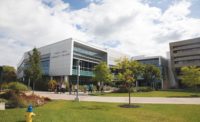
Figure 1. The OSU Energy Center.
The first university cogen plant in the U.S. to earn LEED® Platinum certification, the OSU Energy Center succeeded via consistently efficiency-minded design and an exceptional level of analysis and teamwork in the commissioning process. Fuel flexibility, staff training, and a projected $650,000 annual savings didn’t hurt, either.
The Oregon State University (OSU) Energy Center is the first university cogeneration plant in the U.S. to achieve LEED® Platinum certification from the USGBC.
The 6.5-MW Energy Center replaces a failing 90-yr-old heating plant housing five original steam boilers dating from the 1950s. One of the boilers had been inoperable for several years, and the failure of another left only three operational, leaving the plant no longer able to meet the campus steam demand if outside air temperatures dropped below 27

Figure 2. The “jet engine inside a box” (inside the CTG
enclosure).
ROBUST ENGINEERING DESIGN ENSURES RELIABILITY
OSU requires steam and electricity not only for campus heating and operations, but also for research applications. Carter Burgess (now part of Jacobs Engineering) designed a robust system to ensure reliability. A gas-fired combustion turbine generator (CTG) produces 5.5 MW of electricity at 13.8 kV for distribution at 20.8 kV. Exhaust waste heat is utilized in the downstream heat recovery steam generator (HRSG) to produce 27,000 lb/hr 200 psi, 388° high-pressure steam, with an integral duct burner to produce up to 110,000 lb/hr to meet additional campus steam demand.Two auxiliary boilers of 82,500 lb/hr each provide a backup steam source and are also available if peak steam demand exceeds the capacity of the HRSG. The plant is designed to support a future campus system demand of up to 250,000 lb/hr. Steam from the HRSG and auxiliary boilers runs through a steam turbine generator (STG), which generates up to an additional 1.0 MW of electricity and reduces the steam pressure to 60 psi, 339° (slightly superheated), for use in the existing campus steam-distribution system.

Figure 3. Overhead view of the CTG, STG, and HRSG.
In addition to natural gas, the system can also operate on a variety of liquid and gas fuel sources, including biofuels. This provides OSU with future flexibility in choosing the lowest cost fuel as market conditions change, as well as the ability to use locally produced biofuels as they become available.
MAXIMIZING SUSTAINABILITY
The Energy Center is also designed to take advantage of the latest technologies to maximize efficiency and minimize energy waste, including extensive use of heat exchangers to capture and reuse waste heat in the cogeneration process and building operations. For example, a heat exchanger (economizer) on the HRSG is used to pre-heat the boiler feed water, recovering exhaust heat that would otherwise be wasted. Another heat exchanger downstream of the boiler feedwater economizer recovers most of the remaining heat from the exhaust to preheat the condensate returned from the campus before it is returned to the cycle. A heat exchanger connected to the boiler feedwater system header captures excess heat, which is used in a radiant floor loop to heat the office, control room, and supporting spaces during cooler months. The plant even recovers the heat energy from blowdown steam to preheat the plant makeup water, providing additional efficiency to the plant with the added environmental benefit of avoiding dumping hot water to drain.In accordance with OSU’s strong commitment to sustainability, the project utilizes many additional sustainable features. Oh Planning + Design LLC, architect of record, working with LEED consultants Green Building Services, designed the building with ample daylighting and natural ventilation, a white reflective roof, water-efficient landscaping and irrigation, and high-efficiency lighting and plumbing fixtures. Additionally, rainwater is captured for use in the plant, easing both the load on the storm sewers and reducing the plant’s water usage.
COMMISSIONING DESIGN REVIEW ASKS ‘WHAT IF ...?'
The complex project required a high level of commissioning services, including verification of the functionality of the system in accordance with original engineering design intent, careful consideration of the start-up procedures, and installation quality.As commissioning authority, Heery International became involved with the project in the design phase, conducting a design review focusing on three areas: development of the processes to be used for start-up and testing of systems during construction; development of standard operating procedures; and analysis of the design capacity of the systems under standard operational and failure/backup modes.
For example, the commissioning team determined that the proposed 350-kW diesel generator was undersized for the automatic transfer of critical loads during a black-start operation as the engineering design intended. The revised design provided for a 750-kW generator, sized to start either the CTG/HRSG train or auxiliary boilers, providing uninterrupted steam and power distribution to the campus, and greatly simplifying the plant restart after utility power failure.

Figure 4. HRSG economizer and makeup water preheater maximize
heat capture.
The project also required commissioning of the interface between the process controls, building automation controls, and the campus supervisory control and data acquisition system, highly complex systems not normally associated with typical building commissioning. The commissioning team’s analysis of the sequence of operation under standard operational and failure/backup modes enabled CH2M HILL, the project PLC controls subcontractor, to program the PLC to the appropriate sequence of operations under each condition.
MAINTAINING CONTINUOUS STEAM PRODUCTION THROUGHOUT CONSTRUCTION
The commissioning team provided technical assistance for construction sequencing and coordination, as well as functional testing. In particular, the project required detailed planning and coordination of functional testing and cutover activities to enable the project team to complete construction, commissioning and operator training of the new Energy Center while maintaining continuous steam production to the campus. The Heery commissioning team worked closely with the project’s contractor, Andersen Construction, to coordinate all startup and commissioning activities to avoid interruptions in steam production to the campus throughout the project duration - a task akin to rebuilding the engine of a car while driving down the highway.For example, Andersen Construction, OSU, and the commissioning team developed a sequence to test and cutover to the auxiliary boilers in the new Energy Center in early 2009 to ensure reliable steam production for the winter, followed by startup and cutover to cogeneration in early 2010. This unusual sequence put construction of the building, installation of the auxiliary boilers and piping, and functional testing and commissioning of the auxiliary systems before installation of the combustion turbine generator and steam turbine generator.

Figure 5. HRSG burner valvetrains allow for flexibility of fuel
sources and future bio-fuels.
While the OSU Energy Center was built with the latest technologies, the project team also kept ties to the past, re-using or recycling equipment from the old plant when practical and logical. This includes “The Davey,” the old steam plant’s 1920s vintage air compressor, which was restored by the plant operators and relocated to the new Energy Center, where it serves as a highly reliable backup to the new air compressors.
MASTERING A ‘JET ENGINE IN A BOX'
With the transition for the old heating plant to new Energy Center, OSU was asking its facilities staff to master a much higher level of operational complexity. Consequently, the plant operators were integrated into the project team from the design phase through building occupancy, which allowed them to share their expertise and experience with the project team while simultaneously gaining familiarity with the new plant and its systems.LotusWorks USA, sub-consultant to Heery for operator training, worked closely with plant operators in development of the standard operating procedures and confirmation of operational design intent. During functional testing, the plant operators worked side-by-side with the commissioning agents to test the operation and interactions of the systems.
OSU also asked the commissioning team to provide the plant operators with full functional training, a level of staff education not commonly seen on projects. The team wrote the training guide framework, monitored and verified the vendor system training, and provided integrated systems training. LotusWorks USA provided training on the fundamentals of operation of the electrical, mechanical, and control systems; training on cogeneration and plant systems; and standard operating procedures.
Training sessions were ongoing throughout the project and were timed to coincide with the system start-ups and transition to operation, so operators would have maximum retention of the training materials. Training demonstrated not only how each individual system works, but also how the plant works together as an integrated system.

Figure 6. The “Davey,” the plant’s 90+ year old air compressor
(note the OSU Beaver mascot radiator cap).
The commissioning authority also provided a 35-lineal-ft library of commissioning documentation and operations and maintenance manuals, two sets of hard copies and interactive CD-ROMs, and collated all the project training materials into a single indexed source, with hard copies and interactive CD-ROMs to allow for convenient access to the information.
The Energy Center has been producing steam since fall 2009 and electricity since summer 2010, operating with minimal problems even through several power outages. As of March 2011, the commissioning team was preparing for the 10-month operational review.
In addition to being the first university LEED Platinum cogeneration plant in the nation, the Energy Center also received a gold designation by the Sustainability Tracking, Assessment and Rating System (STARS) of the Association for the Advancement of Sustainability in Higher Education.
Today, academic, government, commercial, and industrial organizations alike are searching for effective ways to reduce energy costs and environmental impacts. Lessons learned from OSU’s groundbreaking Energy Center can be applied in the design, construction and commissioning of other cogeneration plants across the nation. ES


